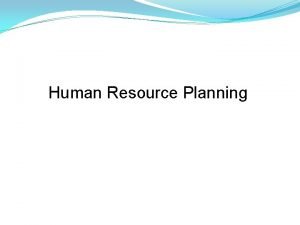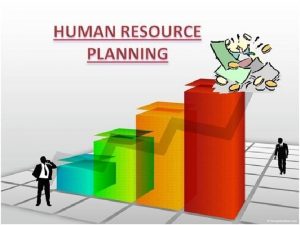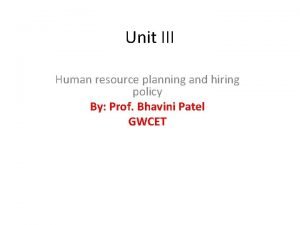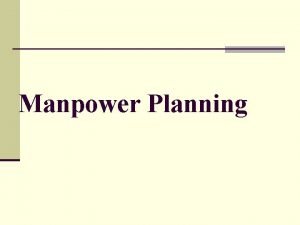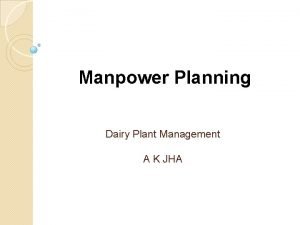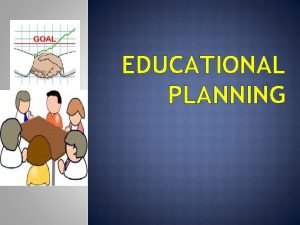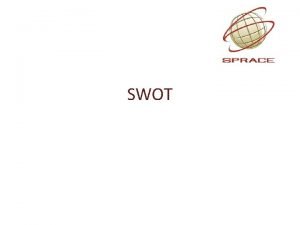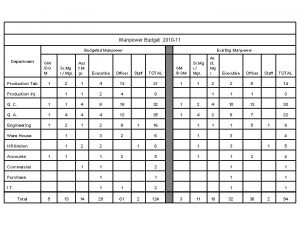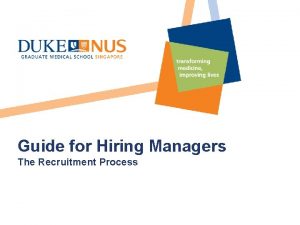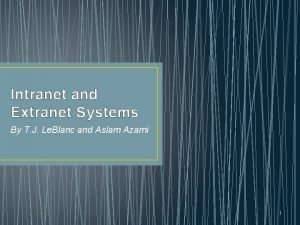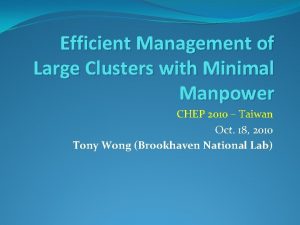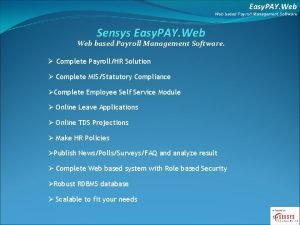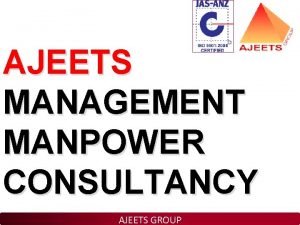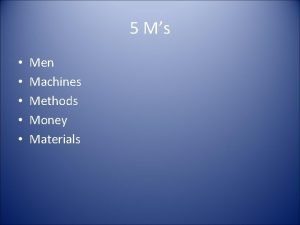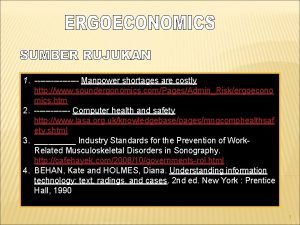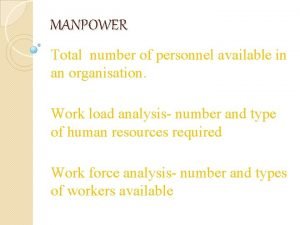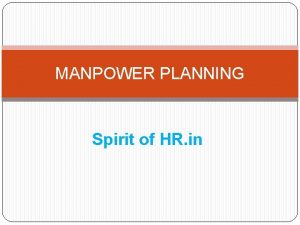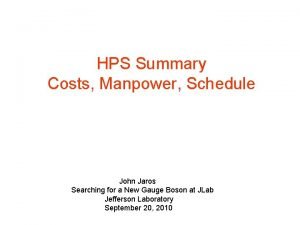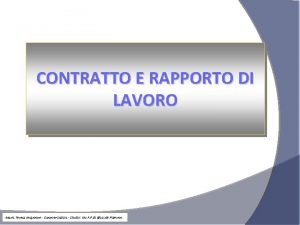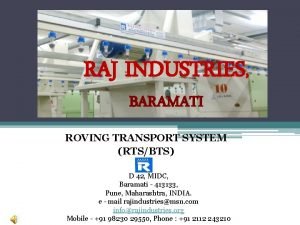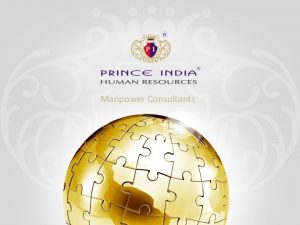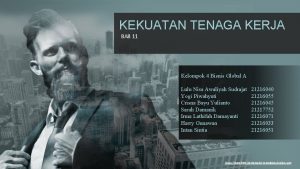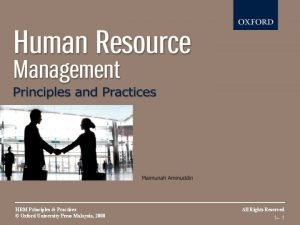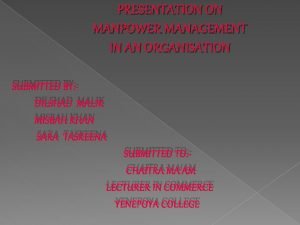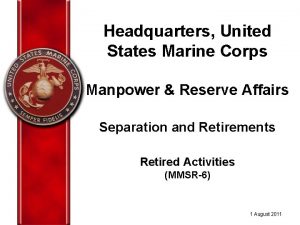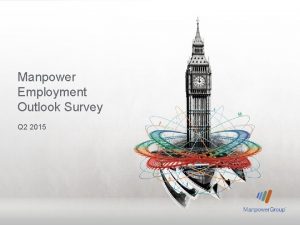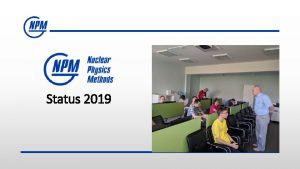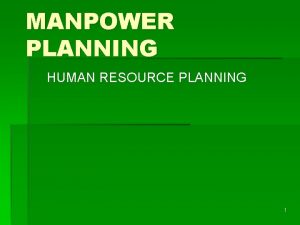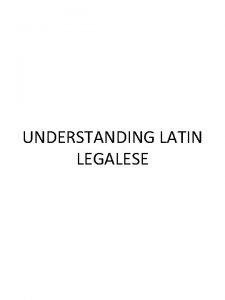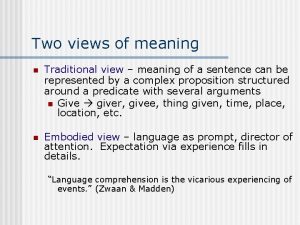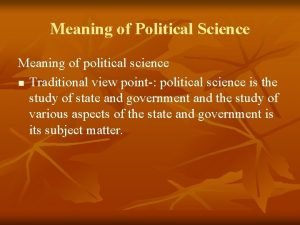MANPOWER PLANNING MEANING OF MANPOWER PLANNING Manpower Planning































- Slides: 31

MANPOWER PLANNING

MEANING OF MANPOWER PLANNING Manpower Planning is essentially the process of getting the number of qualified employees & seek to place the right employees in the right job at the right place so that an organization can meet its objectives. It is a very important part of overall planning of a business organization. It is obvious that a business cannot prosper unless the right number of employees , having required skills , talents & qualifications is available at right time. It is done to fulfill two main objectives: Ø To utilize the present employees fully Ø To fill up future manpower requirements

Definition of Manpower planning “The process by which a management determines how an organization should make from its current manpower position to its desired manpower position. Through planning a management strikes to have the right number & the right kinds of people at the right places, at the right time to do things which result in both the organization & the individual receiving the maximum long range benefit. ” -BY ERIC W. VETTER

features WELL DEFINED OBJECTIVES: - The objectives of the organization in strategic planning & operating planning may form the objectives of human resource planning. Human resource needs are planned on the basis of companies goals. Besides, human resource has its own objectives like developing human resource, updating technical expertise, ensuring better commitment of people & so on. DETERMINING PERSONNEL NEEDS: - Human resource planning is related to the determination of personnel needs in the organization. The thinking will have to be done in advance so that the persons are available at a time when they are needed. The organization may also have to undertake recruiting, selecting & training processes also. HAVING MANPOWER INVENTORY: - It includes the inventory of present manpower in the organization. The manager should know the persons who will be available to him for undertaking higher responsibilities in the near future.

Ø ADJUSTING DEMAND & SUPPLY: - Manpower requirements have to be planned well in advance as suitable persons are not immediately available. In case sufficient persons will not be available in future then efforts should be made to start recruitment process well in advance. The demand & supply of personnel should be seen in advance. Ø CREATING PROPER WORK ENVIORNMENT: - Besides estimating & employing personnel, manpower planning also ensures that proper working conditions are created. People should like to work in the organization & they should get proper job satisfaction.

Need for Manpower planning ü REPLACEMENT OF PERSONS: - A large no. of persons are to be replaced in the organization because of retirement, old age, death etc. There will be a need to prepare persons for taking up new positions in such contingencies. ü LABOUR TURNOVER: - There is always a labour turnover in every organization. The degree of labour turnover may vary from concern to concern but it cannot be eliminated all together. There will be a need to recruit new persons to take up the positions of those who left the organization. If the concern is able to forecast turnover rate precisely then advance efforts are made to recruit & train persons so that work does not suffer for want of workers. ü EXPANSION PLANS: - Whenever there is a plan to expand or diversify the concern then more persons will be required to take up new positions. Human resource planning is essential under these situatio ns.

ü TECHNOLOGICAL CHANGES: -The business is working under changing technological environment. There may be a need to give fresh training to personnel. In addition, there may also be a need to infuse fresh blood into the organization. Human resource planning will help in meeting the new demands of the organization. ü ASSESSING NEEDS: - Human resource planning is also required to determine whethere is any shortage or surplus persons in the organization. If there are less persons required, it will adversely affect the work. On the other hand, if more persons are employed than the requirement then it will increase labour cost etc.

OBJECTIVES… q Assessing manpower needs for future & making plans for recruitment & selection. q Assessing skill requirement in future. q Determining training & development needs of the organization. q Anticipating surplus & shortage of staff & avoiding unnecessary directions. q Controlling wage & salary costs. q Keeping the organization to cope with the technological development & modernization. q Ensuring higher labour productivity. q Ensuring career planning of every employee of the organization & making succession programmes.

Process of Manpower planning DECIDING GOALS & OBJECTIVES ESTIMATING FUTURE MANPOWER REQUIREMENTS MANPOWER INVENTORY PLANNING JOB REQUIREMENTS & JOB DESCRIPTIONS DEVELOPING A HUMAN RESOURCE PLAN

DECIDING GOALS & OBJECTIVES: -Human resource management helps in achieving individual & organization goals. The main purpose is to relate future human resources to the future enterprise needs. ESTIMATING FUTURE MANPOWER REQUIREMENTS: The estimation of manpower requirements, at a given point of time of the organization structure, should be undertaken. Some of the factors to be considered forecasting are: a) LIKELY TREND IN ECONOMIC ENVIRONMENT: -The likely trend in economic environment in the future will determine the level of business activity. b) DEVELOPMENT IN INDUSTRY: -Manpower needs will depend upon the development of industry. If the development is more than there will be more demand of employees. c) WORK-LOAD ANALYSIS: -Workload analysis determines manpower needs in future. This is done on the basis of production schedules or marketing targets. d) WORK-FORCE ANALYSIS: -Workforce analysis helps in determining the number of employees needed in an enterprise. It takes into consideration the labour turnover rate & absenteeism in the unit.

Ø MANPOWER INVENTORY: -The next step is to determine the present supply of manpower. This is done through manpower inventory. It involves the cataloging the characteristics of personnel in the organization, decides counting their number. It involves the following steps: o The first step is to decide who should form a part of it. o After determining the persons to be included in manpower inventory, the second step is to collect information about them. o Next step is to appraise to talent catalogue. The present & future capabilities of persons are assessed. Besides appraisal tests, remarks about persons are also given. SO MANPOWER INVENTORY WILL HELP IN KNOWING THE PRESENT & FUTURE POTENTIAL OF THE EXECUTIVES IN THE ORGANIZATION.

• PLANNING JOB REQUIREMENTS & JOB DESCRIPTIONS: • After deciding how many persons would be needed, it is necessary to prepare job analysis. The data relating to the job may be classified as follows: - 1) Job identification 2) Nature of the job 3) Operations involved in doing the job 4) Materials & equipment required to do the job 5) Personnel qualities required to do the job 6) Relation of the job with other jobs in the organization.

Ø DEVELOPING A HUMAN RESOUCE PLAN: - Human resource plan consists of finding out the sources of labour supply with the view of making an effective use of these resources. Generally, most of the organizations fill up higher vacancy by promotion & lower level position by recruitment from the labour market. The labour market is influenced by many factors such as: 1) Population density 2) Local unemployment level 3) Availability of part time labour 4) Competition for labour force from other organizations 5) Output from the educational system 6) Pattern of in-migration & out-migration 7) Transport facilities & communication pattern THE PERSONNEL MANAGER SHOULD HAVE A THOROUGH KNOWLEDGE OF LABOUR MARKET.

Responsibility for Manpower planning Personnel manager is generally responsible for manpower planning. In this task he is aided by the industrial engineering department & top management. The overall policy in manpower planning is framed by Board of Directors but actual execution is done at personnel dept level. Geisler explains the responsibility of personnel department with regard to manpower planning as follows: � To assist, counsel & pressurize the operating management to plan & establish objectives. � To collect & summarize data in total organization terms & to ensure consistency with long range objectives & other elements of the total business plan. � To monitor & measure performance against the plan & keep the top management informed about it. � To provide the research necessary for effective manpower & organizational planning.

FACTORS AFFECTING MANPOWER PLANNING �EXISTING STOCK OF MANPOWER �WASTAGE �FUTURE MANPOWER REQUIREMENT

1. Existing Manpower Inventory – Utilization of the existing manpower is the first basis of manpower planning and is the starting point of all planning processes. To analyse the existing manpower, one must study the position of total manpower by dividing it into groups on the basis of function, occupation, level of skills or qualification. 2. Wastage – For good planning, appropriate adjustment in the existing stock of manpower should be made for the possible wastage of manpower caused by any foreseeable changes in the organization. 3. Future Manpower Requirements – After evaluating the existing stock of manpower and analyzing the various factors of wastage caused by any foreseeable change in the organization, one may very easily assess the future requirements of manpower in an industry.

Types of Manpower planning Short term manpower planning Long term manpower planning

Ø SHORT TERM MANPOWER PLANNING: -Short term planning is made for a short time that is for a period of more than 2 years. The problems which are faced in the short run are: - a) The weak incumbent b) The strong incumbent c) An unexpected vacancy A. THE WEAK INCUMBENT: -The first & the most difficult problem in short term planning is experienced when an existing personnel is not according to the specifications of the job. In such circumstances, there are four approaches for matching jobs & individuals. i. iii. iv. Changing of the man Change in the contents of the job Changing the job & the man Removal of the incumbent

B. THE STRONG INCUMBENT: -Some people in the organization may have greater ability than their present job requires. In such a case, again there is a problem of matching jobs with the man because a portion of individuals ability remains unutilized. For the proper utilization of the ability, the following approaches may be tried out: - i. Assigning additional duties ii. Assigning some special problems iii. Advice iv. Change in job

C. AN UNEXPECTED VACANCY: -The next problem which the management has to face in the short run is the filling up of posts falling vacant due to some unexpected reasons such as death, resignation or some other social reason. Ø LONG TERM MANPOWER PLANNING: Long term manpower planning is concerned with all jobs & persons at once with matching total available personnel in the organization to total job requirements. The long term manpower planning has the following elements: - i. PROJECTING MANPOWER REQUIREMENTS: -The first essential step in projecting the manpower requirements is to forecast the organization structure. The following factors should be analyzed to forecast the manpower requirements: - a) The rate of loss due to known(example retirement & transfer etc. ) & unknown(example resignation, discharge etc. ) factors may be guessed.

a) The manpower requirement in future will depend upon the expansion or contraction in the size of the organization. b) A job analysis should also help in long term planning. A prediction of what capabilities will be required in the people to perform the job effectively. ii. TAKING STOCK OF EXISTING MANPOWER: -Having projected the manpower requirements, the next step in manpower planning is to take stock of existing manpower & to find out how far the present stock of manpower would fulfill the qualifications of the anticipated jobs or how far they would be developed through training. iii. RECRUITMENT & SELECTION: -Once the requirement of manpower is known, the process of recruitment & selection starts to identify the prospective candidates & to stimulate them to apply for job.

Level Of Manpower planning Plant level Departmental Or Divisional level Top level

• PLANT LEVEL: -Manpower at plant level can be conducted by an operating committee on the basis of past data & future projections. The committee shall prepare a manpower plan for the next year, including the number of employees required & the sources which could be utilized to meet these requirements. • DEPARTMENTAL OR DIVISIONAL LEVEL: -The plant level plan would be submitted to the next organizational level which would be the departmental level. The divisional committee would integrate all the manpower plans of its plants as well as those of its divisional staff sections. • TOP LEVEL: - At the top level, departmental plans are reviewed & integrated with manpower plans for head office staff. Special emphasis is placed at this level on management development plans. Finally, the company’s manpower plans is integrated with the organizational plans.

BENEFITS OF HUMAN RESOURCE PLANNING Human Resource Planning(HRP) does not stop with finding the required kind and number of employees but also determines the action plan for all the function of personnel management. The major benefits of human resource planning are: v REDUCED LABOUR COSTS: -With the help of manpower planning management is able to anticipate shortages & surpluses of manpower. v OPTIMUM UTILISATION OF MANPOWER FORCE: -With the help of manpower planning there is optimum utilisation of labour force in the organization. Workers are given those jobs to perform for which they are skilled. v IDENTIFICATION OF GAPS IN EXISTING MANPOWER: - Human resource planning identifies gaps in existing manpower in terms of their quantity & quality with the help of suitable training or any other steps.

�Improvement in overall business: Manpower planning is an integral part of overall business planning. Effective manpower planning will lead to improvement in overall planning also. �Career Succession Planning: Manpower planning facilitates career succession planning in the organisation. It provides enough lead time for internal succession of employees to higher position through promotions. �Creates Awareness in the Organisation: Manpower planning leads to a great awareness about the effectiveness of sound manpower management throughout the organisation. �Growth of the organisation: Manpower planning facilitates the expansion and diversification of an organisation. �Beneficial to the country: At the national level manpower planning facilitates educational reforms geographical mobility of talent.

Problems in manpower planning Ø RESISTANCE FROM EMPLOYEES: -Many employers resist HRP as they think that it increases cost of manpower as trade unions demand for employee based plans, more facilities and benefits including training and development. Ø ACCURACY OF FORECASTS: -Manpower planning involves forecasting the demand & supply of human resources. Thus the effectiveness of planning depends upon the accuracy of forecasts. Ø IDENTITY CRISIS: -Many human resource specialists & the managers do not understand the whole manpower planning process because of this there is generally an identity crisis. Ø SUPPORT OF TOP MANAGEMENT: -It requires full & whole hearted support from the top management.

Ø UNCERTAINITIES: -Uncertainties are quite prominent in human resource practises due to absenteeism, seasonal employment, labour turnover, changing technologies, market conditions making HRP less reliable. Ø MANAGEMENT INFORMATION SYSTEM: -Information system regarding human resources has not yet fully been developed due to industries giving low status to personnel department and less importance given to HRP. Further the reliable data and information about the economy, other industries, labour market, trends in human resources are not available. Ø INSUFFICIENT INITIAL EFFORTS: -Successful human resource planning flourishes slowly & gradually. Sometimes sophisticated technologies are forcefully introduced just because competitors have adopted them. Ø EXPENSIVE & TIME CONSUMING: -It is an expensive & time consuming process. Employers may resist manpower planning feeling that it increases the cost of manpower.

ØCOORDINATION WITH OTHER MANAGERIAL FUNCTIONS: There is generally a tendency on the part of the manpower planners to remain aloof from other operating managers & to become totally absorbed in their own world. Ø UNBALANCED APPROACH: -Many human resource experts give more importance on the quantitative aspect of manpower to ensure that mere is adequate flow of people in & out of the organization.

Suggestion for making Manpower planning effective INTEGRATION WITH ORGANIZATIONAL PLANS: -It must be balanced with organizational plans. It must be based on the organizational objectives & plans. PERIOD OF MANPOWER PLANNING: -Period of the planning should be appropriate to the needs & circumstances of the enterprise in question. PROPER ORGANIZATION: -To be effective, the planning function should be properly organized. If possible, within the human resource dept, a separate cell or committee should be constituted.

SUPPORT OF TOP MANAGEMENT: -To be effective in the long run, manpower planning must have the full support of the top management. The support from top management is essential to ensure the necessary resources, cooperation & support for the success of the planning. INVOLVEMENT OF OPERATING EXECUTIVES: -Human resource planning is not a function of manpower planners only. To be effective, it requires active participation & coordinated efforts on the part of operating executives. EFFICIENT & RELIABLE INFORMATION SYSTEM: -To facilitate human resource planning, an adequate data base must be developed for human resources. BALANCED APPROACH: - The human resource experts should give equal importance to both quantitative & qualitative aspects of manpower.

CONCLUSION…. GETTING THE RIGHT PEOPLE AT THE RIGHT PLACE ON THE RIGHT TIME…….
 Meaning of manpower planning
Meaning of manpower planning Manpower planning definition and importance
Manpower planning definition and importance Human resource planning means
Human resource planning means Manpower planning definition
Manpower planning definition Manpower planning introduction
Manpower planning introduction Manpower planning process
Manpower planning process Objectives of manpower planning
Objectives of manpower planning Manpower planning
Manpower planning Conclusion
Conclusion Manpower strengths and weaknesses
Manpower strengths and weaknesses Manpoweronline
Manpoweronline Manpower costa rica
Manpower costa rica Man power budget
Man power budget Flowchart examples
Flowchart examples Manpower bt
Manpower bt T mobile extranet bt
T mobile extranet bt Minimal manpower
Minimal manpower Sensys easy pay
Sensys easy pay Ajeets group
Ajeets group Man machine money method material
Man machine money method material Bisa manpower
Bisa manpower Number of personnel
Number of personnel Firma manpower
Firma manpower Manpower schedule
Manpower schedule Riddles about hobbies
Riddles about hobbies Manpoweronline registrazione
Manpoweronline registrazione Roving automatic transport system
Roving automatic transport system Gulshan manpower delhi
Gulshan manpower delhi Kekuatan tenaga kerja dalam bisnis internasional
Kekuatan tenaga kerja dalam bisnis internasional Manpower department malaysia
Manpower department malaysia Manpower presentation
Manpower presentation Maradmin 636/20
Maradmin 636/20


